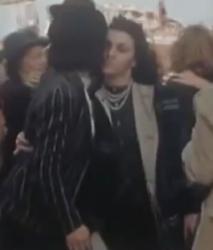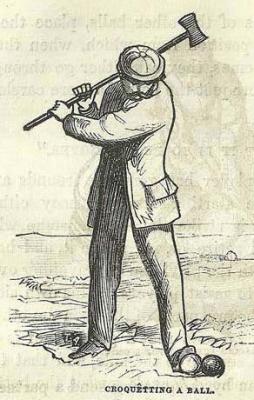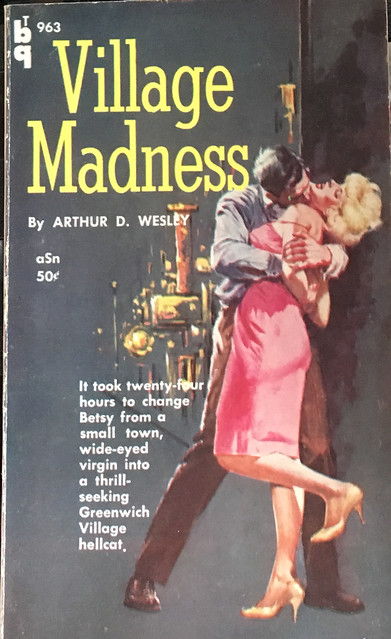The Ballroom Scene from "I Don't Want to be a Man" - 1918
Ernst Lubitsch frequently inserted comical dance scenes into his films, and this is no exception.
The premise is that a young lady, unhappy with her lot, impersonates a man. She then finds out it's not all it's cracked up to be.
This film provides a wonderful snapshot of Ragtime era Fox Trot/One Step.
Some Thoughts on the Home Movie Footage of Social Dancing at the 1939 World's Fair
 There is a remarkable bit of film, taken some time in 1939 or 1940, from the New York World's Fair. It is silent, in color and features numerous couples, black and white but mostly all female, swing dancing and fox trotting to the music of Glen Gray and the Casa Loma Orchestra.
There is a remarkable bit of film, taken some time in 1939 or 1940, from the New York World's Fair. It is silent, in color and features numerous couples, black and white but mostly all female, swing dancing and fox trotting to the music of Glen Gray and the Casa Loma Orchestra.
It comes from a wonderful series of amateur films taken by a fellow named Medicus that documents nearly all aspects of the Fair.
This clip is all over YouTube with any number of soundtracks. I found my footage on the Prelinger Archive portion of the Internet Archive.
This footage is valuable to the dance historian for a variety of reasons, not the least of which is that, unlike so much of our film documentation of people dancing in the 1930s, it is neither a staged Hollywood scene with professional dancers nor a newsreel about a dance contest. These are ordinary Americans, most of whom probably had no idea they were going to be dancing when they got up that morning. This is spontaneous and very revealing of the way people danced at the time, and generational differences in peoples' dance choices.
Of course, the first thing anyone will notice about this film is the shortage of men. It is nearly all (but not entirely) women dancing together. The conclusion that I have often seen in comments online is that the boys were all off at war, but that wouldn't seem to apply here. The US didn't go to war until a year after the Fair closed in November 1940, and the draft wasn't established in the US until October of 1940. The boys were still at home, they just weren't up there dancing. Furthermore, this was a time when most boys did know how to dance, more or less. It was an essential social skill, so purely mathematically, it would seem like they should be up there in greater numbers.
I've pondered this a bit, and my conclusion is that it must be a matter of social dynamics. Those people were there with their families or with their gaggle of friends, and I suspect only a few of those girls came with their boyfriends. So, there they were, in a crowd of strangers, a world-famous dance band is playing and a place for dancing has been laid out (and it's FREE!). What's a girl to do? In most cases, I think the answer was for her to grab her sister or female friend, or perhaps even ask a random girl to dance. The answer would not have been to ask a strange boy to dance. That would have been too forward and socially dangerous.
So, since girls were generally perfectly happy to dance with other girls, but boys didn't dance with other boys (and asking a strange girl to dance in that situation would have been a bit too bold for most boys), the girls danced while all but a few of the boys watched.
The Rules for Croquet: 1865
 Croquet is a very popular pastime in the historical costuming community. We set up a picnic, we deploy our wickets and start smacking our balls.
Croquet is a very popular pastime in the historical costuming community. We set up a picnic, we deploy our wickets and start smacking our balls.
However, we generally use the rules we know from our youth - and this is not necessarily as it was done in the mid 19th Century when it was at the height of its popularity.
Linked from this page is a facsimile scan of a pocket-sized book on how Croquet was played in the Victorian era around the time of the American Civil War.
How to Play Croquet: A New Pocket Manual of Complete Instructions for American Players
Illustrated with engravings and diagrams
Together with all the rules of the game, hints on parlor croquet and a glossary of Technical Terms.Boston, Published by Adams and Company. 1865.
(Authorship unknown).
I would like to thank my talented friend Tim Steinmeier for this beautifully executed facsimile scan of a book that was provided by the International Printing Museum in Carson California, where Tim is a volunteer.
Download the book
Foxtrot Part 3: The King of All Dance
From the 1920s until the early '50s, every dance piece in 4/4 time, whether it was Charleston, Black Bottom, Swing or even Rock and Roll, was published as "Fox Trot". Here is a brief slideshow/montage illustrating that fact.
The Muybridge Waltzes: Clothed and Unclothed - 1887
This is my animation of three of Eadweard Muybridge's "Animal Locomotion" studies from 1887. He pioneered a technique of capturing movement using multiple high speed cameras. It was originally developed to settle a bet between millionaires, but he then went on to use it to capture the motion of humans and animals doing any number of things. Given how concealing and constraining Victorian clothing was, he frequently made use of nude models. In the case of the naked dancing couple, a plausible explanation is that Victorian sensibilities would be too shocked by a naked man and woman dancing together, so he opted for two naked women as being less scandalous.
These represent the earliest moving images of social dancing. Films are easy to find for students of 20th Century dance, but for those studying the social dance of the 19th Century, this is really all there is. They were, of course, originally multiple still images, but when you put them together, they become a motion picture.
The original studies consisted of consecutive shots of people dancing a Waltz. In my animation, first I show them frame by frame and then speed it up to get a sense of motion. It includes three studies: a clothed man and woman, two nude women waltzing together and one nude woman waltzing alone.
If we can get past the "Oh, naked ladies" reaction, there's actually much to be learned from these videos.
A Collection of Vintage Adult Book Cover Art
| This particular posting will be something of a departure for me, though I suppose it does have some connection to "Social History".
In the process of dealing with the estate of a deceased relative, I came upon several stashes of "vintage" adult literature - perhaps 600 volumes in total. Much is cheaply produced and, well, just porn; but about half of it dates from the late '50s through the late '60s, when "adult" literature often had cover art that ranged from crude but enthusiastic to expertly executed - clearly produced by the same talented artists who were doing cover art for more "respectable" paperback books. Alas, much of it was too water damaged to even scan, so this collection is the survivors. So, here they are, posted to Flickr in no particular order. They are an interesting snapshot of a moment in our history, at the cusp of the "Sexual Revolution", when euphemisms abound and the word "Shame" figures prominently in the cover text of many of them; but many others aren't ashamed at all. Note: there's one exception to the timeline. You will see a few that date from the '30s and '40s, but mostly it's the late '50s and '60s. Since a big part of what I do for a living is digitizing stuff (I'm really fast) and the collection was about to be broken up forever in an estate sale, I decided to capture it while I could in all its infinite strangeness. There are over 460 items in the collection. PS: I also included the scan of the back cover of one of the books, containing a note that apologizes for not being able to use the mail. I suspect that is related to the draconian laws then in effect relating to sending pornography through the mails.
|

|
The Gigolo's Tango
The signature dance of the gigolo, as depicted in a selection of old movies. A nice review of what a polished Tango looked like in the '30s and '40s.
Dancing in a London Dive 1929
Dancing in a London dive from the Anna May Wong film "Piccadilly" from 1929.
It opens with a bunch of women doing a Charleston and then moves to general, lively social dancing to include a scandalous inter-racial dance. I cut the bit where the landlord throws the black man out as it detracted from my general purpose of showing the dances of the time.

